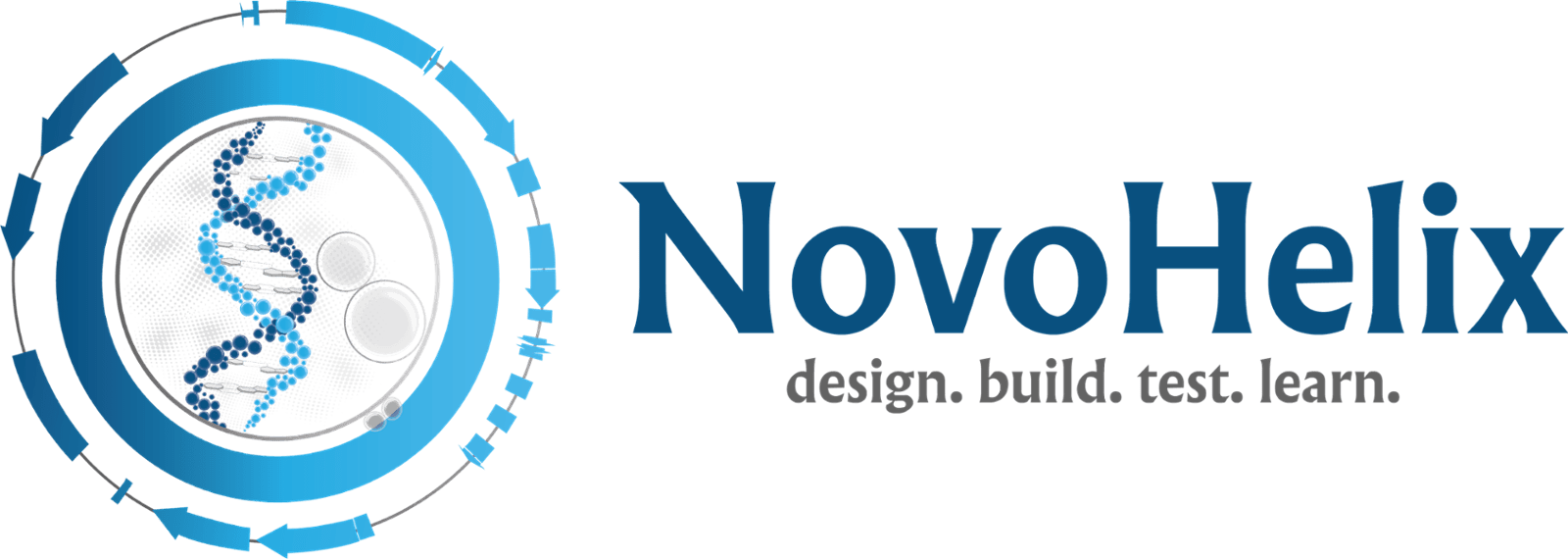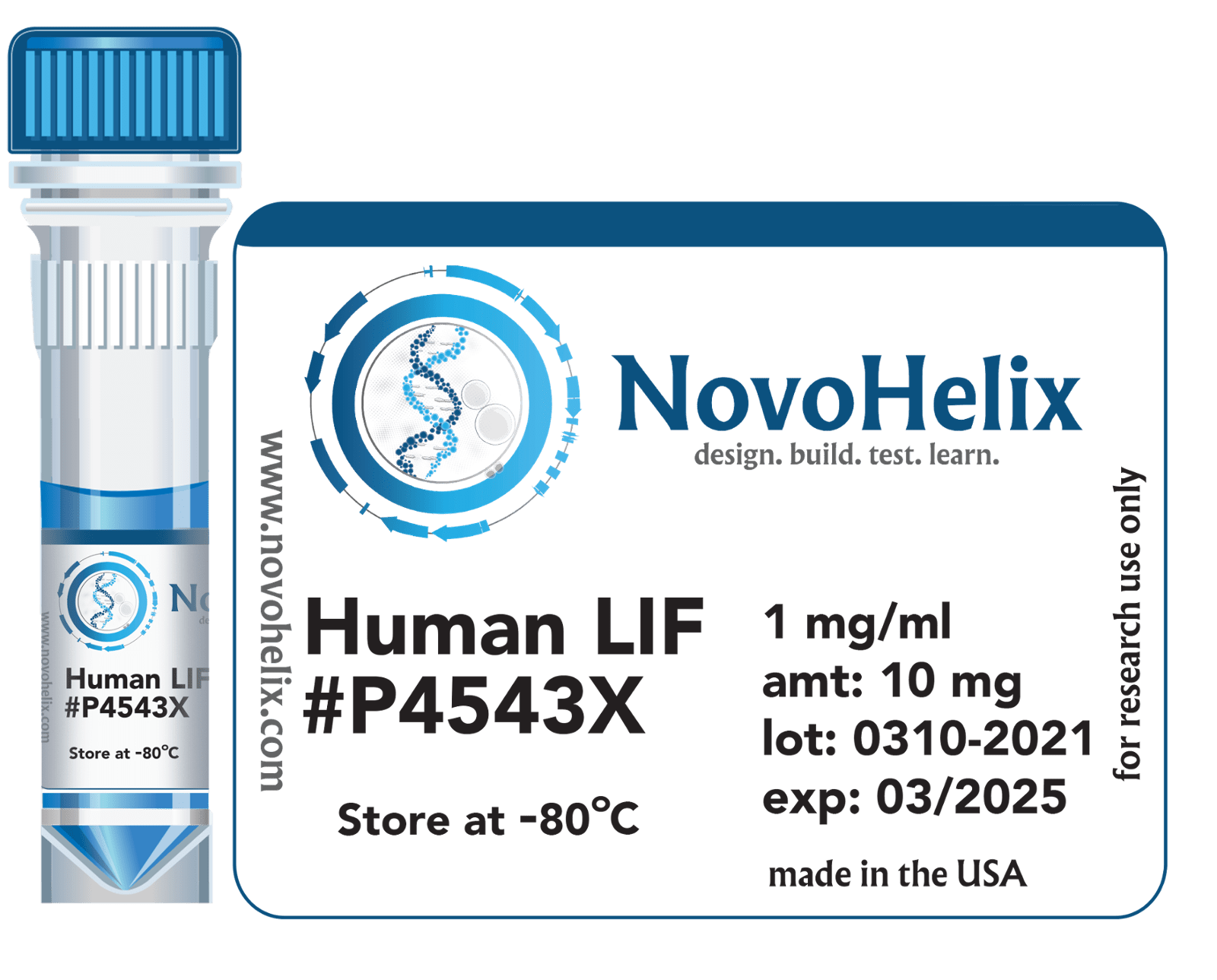Human LIF
The current trend of human pluripotent stem cell (hPSC) culture systems is to replace animal-derived materials such as FBS, BSA and supportive matrices such a Matrigel/Geltrex, a mouse-derived extracellular matrix, with defined factors in the media. At NovoHelix, our products are manufactured in the USA using chemically-defined components and, therefore, do not contain manufacturing components such as serum or animal-derived raw materials. Animal-derived materials are complex undefined mixtures and are recognized as significant risks for stable cultivation and clinical application since they have lot-to-lot variations and risk of immunogenic contamination. In addition, the undefined nature of these raw animal products makes it difficult to deconvolute the essential factors that drive growth, maintenance and differentiation programs.
Basic experimentation in early human development is hampered by the paucity of fetal material available to study typical developmental trajectories, by ethical issues associated with using human fetal tissues, and by a dearth of knowledge of the genetic and molecular programs that direct human embryogenesis and gametogenesis. Therefore, cellular models are a critical resource to understand dysgenesis and to advance our understanding of human infertility. NovoHelix’ approach to personalized medicine is to develop autologous cell models via epigenetic reprogramming of a patient’s own biopsied cells to pluripotency to create induced pluripotent stem cells (iPSCs). A refined reprogramming procedure using Sendai-viral RNA and pioneer factors such as OCT4/SOX2/KLF4 generates iPSCs akin to human embryonic stem cells (collectively known as hPSCs). When these hPSCs are bathed in media containing the appropriate supportive cues to differentiate into somatic and germ cell lineages, these cell-specific models yield enormous potential to better understand the mechanisms of cell specification. NovoHelix has manufactured a line of xeno-free cell reagents to support the establishment of clinical-grade human PSCs and to recapitulate some of the dynamic media environments necessary to elucidate key factors to boost our understanding of human development.
Product
Catalog Nr
Size
Concentration
Pricing
Human LIF
P4543B
bulk
Want to try this product? Request a sample of human LIF.
Product Information
Product Literature & Protocol
FAQs & Troubleshooting
References
Supporting Documents
Product Information
Source:
Recombinant hLIF was improved through protein engineering efforts including directed evolution and rational design. The final engineered protein was synthesized as a codon-optimized minigene and expressed heterologously in an E. coli strain. The recombinant protein was tested and normalized to standard activity assays for growth of naïve mouse and human pluripotent stem cells.
Molecular Weight:
9110.6 ± 2 Daltons
Purity:
>98 % by SDS-PAGE and analysis by protein mass spectrometry
Sequence Analysis:
Purified recombinant protein was subjected to peptide mass fingerprinting (PMF) by MALDI-TOF/TOF (PMF + MS/MS).
Cross Reactivity:
Human, rhesus, cynomolgus/cercopithecine, mouse/murine, rat/murine, pig/porcine, cow/bovine, goat/caprine, dog/canine, cat/feline, horse/equine
Biological Activity:
Proliferation of a naïve pluripotent mouse embryonic stem cell line cultured under 5% oxygen tension on a recombinant laminin 521 matrix with a serum-free DMEM/F12 standard basal media containing FGF2, TGFβ, Activin A, transferrin, vitamin C (L-ascorbic acid-2-phosphate), HRG1β (heregulin-1β), recombinant 0.1% HSA and supplemented with human LIF (ED50 < 20 ng/ml). The hPSC line contains OCT4-P2A-tdTomato knock-in at the human POU5F1 locus to indicate which colonies are still pluripotent. 10⁷ units is equivalent to approximately 100 μg of recombinant hLIF protein.
Endotoxin:
Lipopolysaccharide (LPS) was determined by the standard LAL (Limulus amebocyte lysate) test to be < 0.5 EU/µg. Due to potential environmental sustainability concerns (collection of the hemolymph used in pharmaceutical testing may negatively affect horseshoe crab populations), a quantitative and more sensitive endotoxin assay was developed using a pyrogen‐testing cell model with knock-in (targeted, single-copy integration) of TLR4/CD14/MD2 at the safe harbor locus AAVS1/PPP1R12C on human chromosome 19. The TLR4/CD14/MD2 assay is used as an orthogonal screen for LPS in lieu of the LAL method and has a detection limit of 0.005 EU/ml.
Appearance:
A sterile, aqueous, clear and colorless solution.
Storage/Stability:
Recombinant hLIF is supplied at 1 mg/ml in stabilization buffer and remains bioactive for 30 days if maintained refrigerated [2º to 8ºC (35º to 46ºF)]. Stock solutions of human LIF in its concentrated form can be stored at least 6 months at -20°C and at least 12 months at -80°C from the date of manufacture with no loss of activity on ES cells. For long term storage, add 0.1% w/v carrier protein such as recombinant human serum albumin (HSA) and avoid repeated freeze-thaw cycles by aliquoting. Multiple freeze-thaw cycles reduce potency and, therefore, aliquoting working stocks is strongly recommended.
Reconstitution:
Recombinant hLIF is supplied reconstituted at 1 mg/ml in a stabilization buffer containing 9 mg/mL benzyl alcohol, 50 mM sodium phosphate, 250 mM sodium chloride, 2 mg/mL polysorbate 20, 10% v/v glycerol at a pH of approximately 7.4. The reconstituted solution has been filter sterilized by passing through a 0.22 micron PES membrane and tested to be negative for mycoplasma contamination.
Disclaimer & Precautions:
This product is solely for research and development use only and may be subject to conditional use and licensing restrictions. The product shall not be used as an advanced pharmaceutical intermediate (API) or investigational drug or a biologic. This product is not intended to be used as a therapeutic agent or facilitate clinical diagnosis or be used as an in vitro diagnostic (IVD) product.
The Food and Drug Administration (FDA) and Center for Biologics Evaluation and Research (CBER) define an IVD as:
“In vitro diagnostic products are those reagents, instruments, and systems intended for use in the diagnosis of disease or other conditions, including a determination of the state of health, in order to cure, mitigate, treat, or prevent disease or its sequelae. Such products are intended for use in the collection, preparation, and examination of specimens taken from the human body. These products are devices as defined in section 201(h)of the Federal Food, Drug, and Cosmetic Act (the act), and may also be biological products subject to section 351 of the Public Health Service Act. Title 21, Code of Federal Regulations (CFR), section 809.3(a).”
This product may not be used or formulated in any agricultural, pesticidal, veterinary or animal products, food additives or household chemicals or any other unspecified use. Please consult the Safety Data Sheet for information regarding hazards and safe handling practices. NovoHelix distributes products for basic and translational research use only. NovoHelix will report any unspecified use to respective regulatory authorities for enforcement to ensure safeguarding of our research products from potential abuse.
Notice to purchaser:
The purchase price of this product includes a limited, non-transferable license under U.S. and foreign patents or applications owned by NovoHelix to use this product. No other license under these patents or applications is conveyed expressly or by implication by purchase of this product.
Product Literature & Protocol
- HiFi DNA Assembly Protocol
Recommended Amount of Fragments Used for Assembly
| 2–3 Fragment Assembly* | 4–6 Fragment Assembly** | Positive Control✝ | |
| Recommended DNA Molar Ratio | vector:insert = 1:2 | vector:insert = 1:1 | |
| Total Amount of Fragments | 0.03–0.2 pmols* X μl | 0.2–0.5 pmols** X μl | 10 μl |
NovoHelix HiFi DNA Assembly Master Mix | 10 μl | 10 μl | 10 μl |
| Deionized H2O | 10-X μl | 10-X μl | 0 |
| Total Volume | 20 μl✝✝ | 20 μl✝✝ | 20 μl |
* Optimized cloning efficiency is 50–100 ng of vector with 2-fold excess of inserts.
Use 5 times more insert if size is less than 200 bp. Total volume of unpurified PCR fragments in the assembly reaction should not exceed 20%.
**To achieve optimal assembly efficiency, design ≥ 20 bp overlap regions between each fragment with equimolarity (suggested: 0.05 pmol each).
† Control reagents are provided for 5 experiments.
†† If greater numbers of fragments are assembled, increase the volume of the reaction linearly by using additional NovoHelix HiFi DNA Assembly Master Mix. Alternatively, pool the DNA fragments into an equimolar mix first and then re-purify these pooled equimolar fragments over a micro-column and elute with a minimum volume (~10-µl). The eluate may be reapplied to the same micro-column membrane to improve elution of large DNA fragments without increasing the final volume..
Recommended Storage Condition:
This assembly mixture can be stored at -20 °C for at least one year. The enzymes remain active following at least 10 freeze-thaw cycles.
FAQs & Troubleshooting
References
1: Betzel C, Visanji M, Dauter Z, Fourme R, Weber W, Marnitz U, Boone T, Pope J, Miller J, Hawkins N, et al. Crystallization and preliminary X-ray analysis of leukemia inhibitory factor. FEBS Lett. 1993 Dec 27;336(2):236-8. PubMed PMID: 8262236.
1: Gough NM, Gearing DP, King JA, Willson TA, Hilton DJ, Nicola NA, Metcalf D. Molecular cloning and expression of the human homologue of the murine gene encoding myeloid leukemia-inhibitory factor. Proc Natl Acad Sci U S A. 1988 Apr;85(8):2623-7. PubMed PMID: 3128791; PubMed Central PMCID: PMC280050.
1: Williams RL, Hilton DJ, Pease S, Willson TA, Stewart CL, Gearing DP, Wagner EF, Metcalf D, Nicola NA, Gough NM. Myeloid leukaemia inhibitory factor maintains the developmental potential of embryonic stem cells. Nature. 1988 Dec 15;336(6200):684-7. PubMed PMID: 3143916.
1: Smith AG, Heath JK, Donaldson DD, Wong GG, Moreau J, Stahl M, Rogers D. Inhibition of pluripotential embryonic stem cell differentiation by purified polypeptides. Nature. 1988 Dec 15;336(6200):688-90. PubMed PMID: 3143917.
1: Gearing DP, Nicola NA, Metcalf D, Foote S, Willson TA, Gough NM, Williams RL. Production of leukemia inhibitory factor in Escherichia coli by a novel procedure and its use in maintaining embryonic stem cells in culture. Nat Biotechnol. 1989 Nov 1;7(11):1157-1161. doi: 10.1038/nbt1189-1157 website link: https://www.nature.com/articles/nbt1189-1157
1: Liu X, Nefzger CM, Rossello FJ, Chen J, Knaupp AS, Firas J, Ford E, Pflueger J, Paynter JM, Chy HS, O'Brien CM, Huang C, Mishra K, Hodgson-Garms M, Jansz N, Williams SM, Blewitt ME, Nilsson SK, Schittenhelm RB, Laslett AL, Lister R, Polo JM. Comprehensive characterization of distinct states of human naive pluripotency generated by reprogramming. Nat Methods. 2017 Nov;14(11):1055-1062. doi: 10.1038/nmeth.4436. Epub 2017 Sep 25. PubMed PMID: 28945704.
1: Theunissen TW, Friedli M, He Y, Planet E, O'Neil RC, Markoulaki S, Pontis J, Wang H, Iouranova A, Imbeault M, Duc J, Cohen MA, Wert KJ, Castanon R, Zhang Z, Huang Y, Nery JR, Drotar J, Lungjangwa T, Trono D, Ecker JR, Jaenisch R. Molecular Criteria for Defining the Naive Human Pluripotent State. Cell Stem Cell. 2016 Oct 6;19(4):502-515. doi: 10.1016/j.stem.2016.06.011. Epub 2016 Jul 14. PubMed PMID: 27424783; PubMed Central PMCID: PMC5065525.
1: Guo G, von Meyenn F, Santos F, Chen Y, Reik W, Bertone P, Smith A, Nichols J. Naive Pluripotent Stem Cells Derived Directly from Isolated Cells of the Human Inner Cell Mass. Stem Cell Reports. 2016 Apr 12;6(4):437-446. doi: 10.1016/j.stemcr.2016.02.005. Epub 2016 Mar 3. PubMed PMID: 26947977; PubMed Central PMCID: PMC4834040.
1: Bredenkamp N, Yang J, Clarke J, Stirparo GG, von Meyenn F, Dietmann S, Baker D, Drummond R, Ren Y, Li D, Wu C, Rostovskaya M, Eminli-Meissner S, Smith A, Guo G. Wnt Inhibition Facilitates RNA-Mediated Reprogramming of Human Somatic Cells to Naive Pluripotency. Stem Cell Reports. 2019 Nov 1. pii: S2213-6711(19)30370-4. doi: 10.1016/j.stemcr.2019.10.009. [Epub ahead of print] PubMed PMID: 31708477.
1: Weinberger L, Ayyash M, Novershtern N, Hanna JH. Dynamic stem cell states: naive to primed pluripotency in rodents and humans. Nat Rev Mol Cell Biol. 2016 Mar;17(3):155-69. doi: 10.1038/nrm.2015.28. Epub 2016 Feb 10. Review. PubMed PMID: 26860365.
1: Gafni O, Weinberger L, Mansour AA, Manor YS, Chomsky E, Ben-Yosef D, Kalma Y, Viukov S, Maza I, Zviran A, Rais Y, Shipony Z, Mukamel Z, Krupalnik V, Zerbib M, Geula S, Caspi I, Schneir D, Shwartz T, Gilad S, Amann-Zalcenstein D, Benjamin S, Amit I, Tanay A, Massarwa R, Novershtern N, Hanna JH. Derivation of novel human ground state naive pluripotent stem cells. Nature. 2013 Dec 12;504(7479):282-6. doi: 10.1038/nature12745. Epub 2013 Oct 30. Erratum in: Nature. 2015 Apr 30;520(7549):710. PubMed PMID: 24172903.
1: Di Stefano B, Ueda M, Sabri S, Brumbaugh J, Huebner AJ, Sahakyan A, Clement K, Clowers KJ, Erickson AR, Shioda K, Gygi SP, Gu H, Shioda T, Meissner A, Takashima Y, Plath K, Hochedlinger K. Reduced MEK inhibition preserves genomic stability in naive human embryonic stem cells. Nat Methods. 2018 Sep;15(9):732-740. doi: 10.1038/s41592-018-0104-1. Epub 2018 Aug 20. PubMed PMID: 30127506; PubMed Central PMCID: PMC6127858.
1: Bourillot PY, Santamaria C, David L, Savatier P. GP130 signaling and the control of naïve pluripotency in humans, monkeys, and pigs. Exp Cell Res. 2019 Nov 5:111712. doi: 10.1016/j.yexcr.2019.111712. [Epub ahead of print] PubMed PMID: 31697928.
1: Habekost M, Jørgensen AL, Qvist P, Denham M. Transcriptomic profiling of porcine pluripotency identifies species-specific reprogramming requirements for culturing iPSCs. Stem Cell Res. 2019 Oct 31;41:101645. doi: 10.1016/j.scr.2019.101645. [Epub ahead of print] PubMed PMID: 31759291.
1: Dong C, Fischer LA, Theunissen TW. Recent insights into the naïve state of human pluripotency and its applications. Exp Cell Res. 2019 Dec 1;385(1):111645. doi: 10.1016/j.yexcr.2019.111645. Epub 2019 Oct 1. PubMed PMID: 31585117.
1: Tomoda K, Takahashi K, Leung K, Okada A, Narita M, Yamada NA, Eilertson KE, Tsang P, Baba S, White MP, Sami S, Srivastava D, Conklin BR, Panning B, Yamanaka S. Derivation conditions impact X-inactivation status in female human induced pluripotent stem cells. Cell Stem Cell. 2012 Jul 6;11(1):91-9. doi: 10.1016/j.stem.2012.05.019. PubMed PMID: 22770243; PubMed Central PMCID: PMC3396435.
1: Velychko S, Adachi K, Kim KP, Hou Y, MacCarthy CM, Wu G, Schöler HR. Excluding Oct4 from Yamanaka Cocktail Unleashes the Developmental Potential of iPSCs. Cell Stem Cell. 2019 Oct 30. pii: S1934-5909(19)30423-0. doi: 10.1016/j.stem.2019.10.002. [Epub ahead of print] PubMed PMID: 31708402.
1: Gao X, Nowak-Imialek M, Chen X, Chen D, Herrmann D, Ruan D, Chen ACH, Eckersley-Maslin MA, Ahmad S, Lee YL, Kobayashi T, Ryan D, Zhong J, Zhu J, Wu J, Lan G, Petkov S, Yang J, Antunes L, Campos LS, Fu B, Wang S, Yong Y, Wang X, Xue SG, Ge L, Liu Z, Huang Y, Nie T, Li P, Wu D, Pei D, Zhang Y, Lu L, Yang F, Kimber SJ, Reik W, Zou X, Shang Z, Lai L, Surani A, Tam PPL, Ahmed A, Yeung WSB, Teichmann SA, Niemann H, Liu P. Establishment of porcine and human expanded potential stem cells. Nat Cell Biol. 2019 Jun;21(6):687-699. doi: 10.1038/s41556-019-0333-2. Epub 2019 Jun 3. PubMed PMID: 31160711.
1: Kime C, Kiyonari H, Ohtsuka S, Kohbayashi E, Asahi M, Yamanaka S, Takahashi M, Tomoda K. Induced 2C Expression and Implantation-Competent Blastocyst-like Cysts from Primed Pluripotent Stem Cells. Stem Cell Reports. 2019 Sep 10;13(3):485-498. doi: 10.1016/j.stemcr.2019.07.011. Epub 2019 Aug 8. PubMed PMID: 31402336; PubMed Central PMCID: PMC6739768.
1: Yuan Y, Spate LD, Redel BK, Tian Y, Zhou J, Prather RS, Roberts RM. Quadrupling efficiency in production of genetically modified pigs through improved oocyte maturation. Proc Natl Acad Sci U S A. 2017 Jul 18;114(29):E5796-E5804. doi: 10.1073/pnas.1703998114. Epub 2017 Jul 3. PubMed PMID: 28673989; PubMed Central PMCID: PMC5530680.
Supporting Documents


